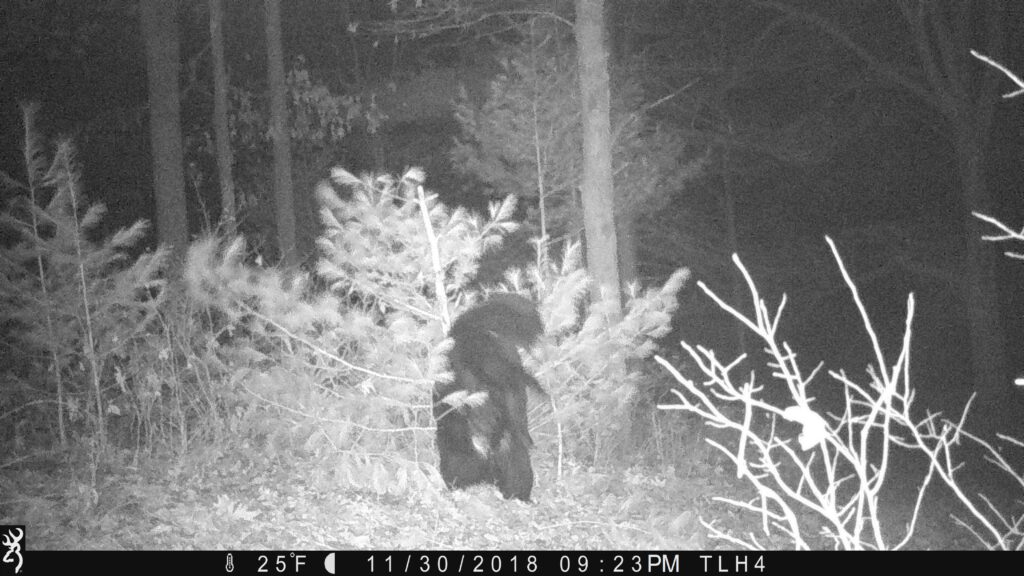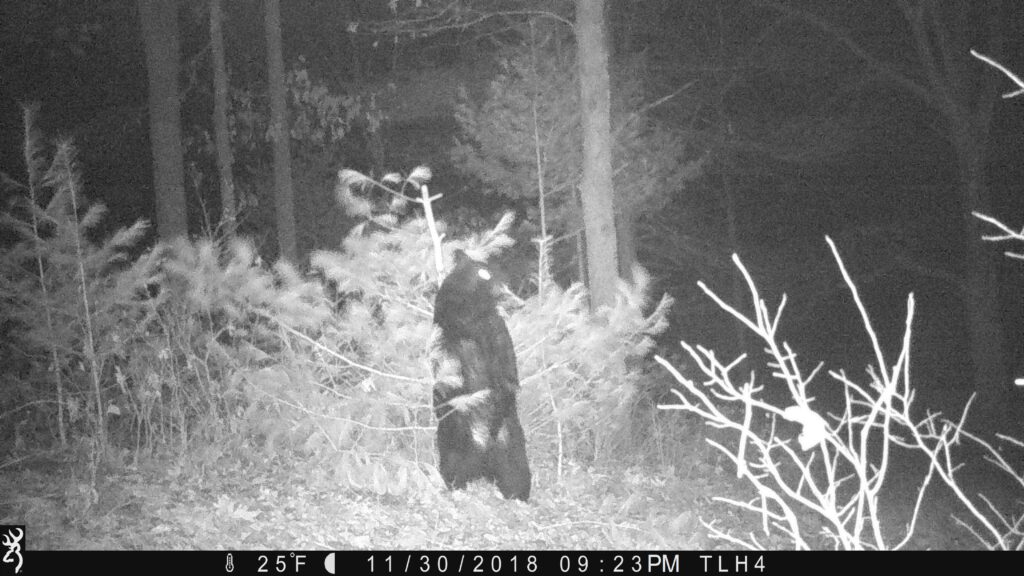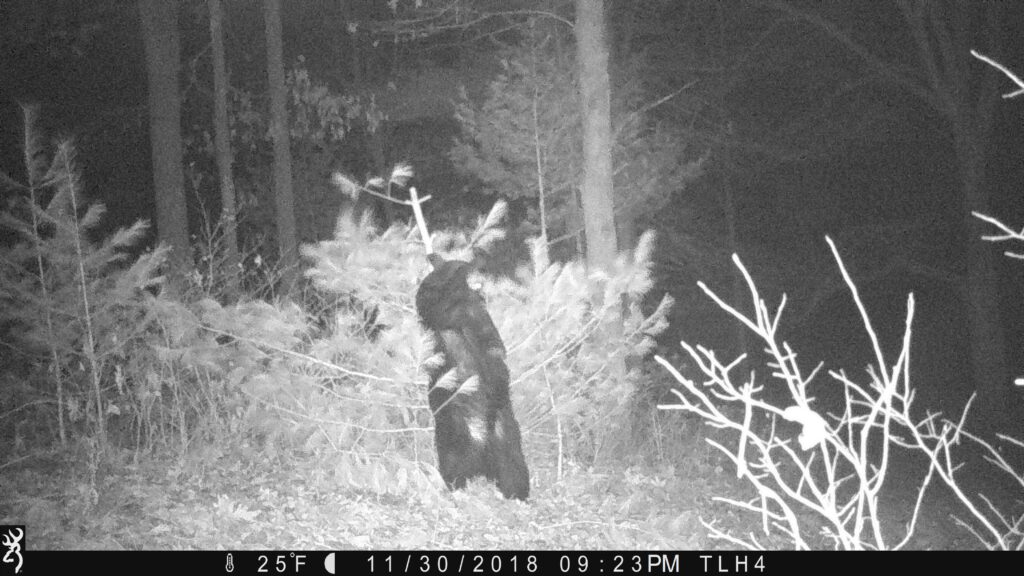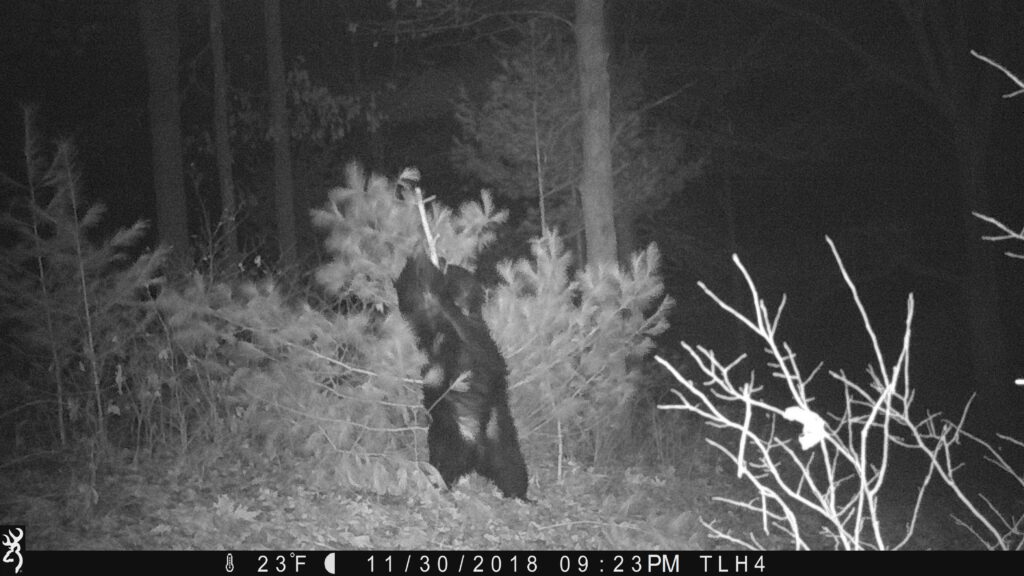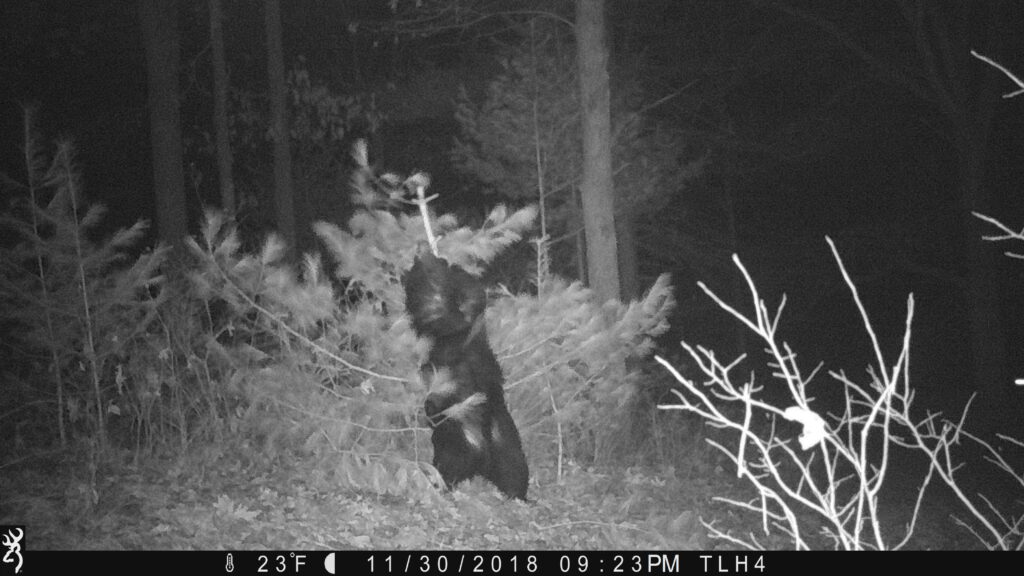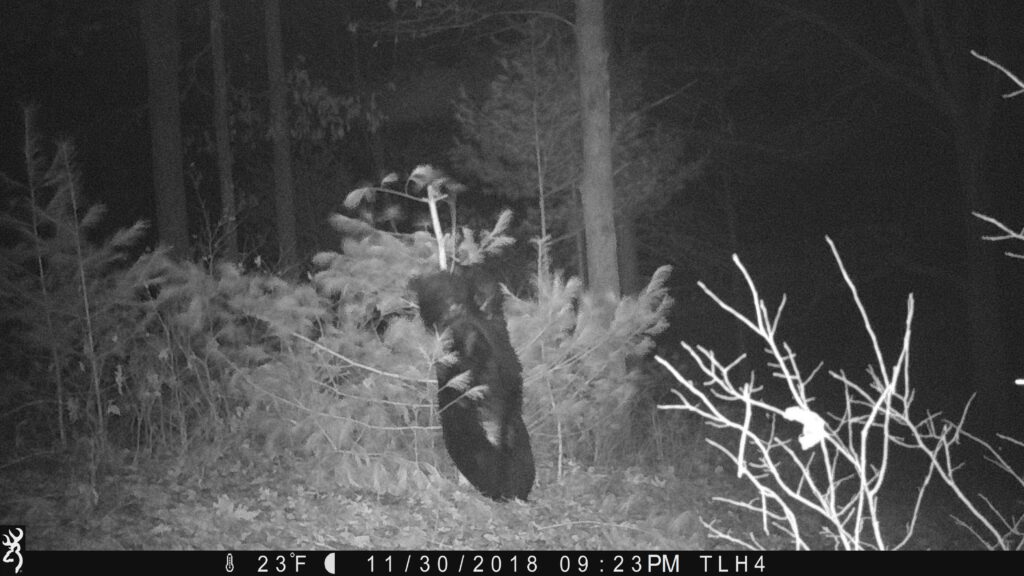Posts Tagged → acorn
PA elk & bear seasons now behind us
You can spend all year excitedly anticipating a few days here or there, and before you know it, those days arrive, they happen intensely, and then they are over like a dream.
This dream we speak of here are the various big game seasons that are such a big part of so many peoples’ lives, entire families and communities, entire businesses (I think hunting is an annual $1.6 BILLION business sector here in Pennsylvania). Thus far we have had an elk season and now the main bear season pass along. Here are some of my thoughts on these two wonderful experiences.
First, the elk hunt.
I was fortunate enough to draw a coveted PA elk tag, after applying for many years and building up a lot of preference points. The lottery drawing was announced in late August, and I immediately began planning. The general elk season is just six days long, and unless you are going to engage a guide for a few thousand dollars, you have a lot of work to do before setting foot afield with a gun. If you draw a bull tag, paying a guide is worth it.
After a tremendous amount of analysis and planning, and some September scouting, I was fortunate to hunt for elk with some good friends and a .62-caliber percussion rifle over my shoulder in Elk Zone 13. We camped out on a log landing in Sproul State Forest, with elk all around us, and each buddy scouted hard each day, looking for elk that the sole hunter (me) could get after.
Elk Zone 13 is huge, and contains a lot of vast public land. And so the elk harvest data shows that it is a bit of a Death Valley in terms of hunters actually killing an elk within it. While a lot of Pennsylvania elk hunting takes place briefly where a lot of the local elk have pet names and are used to being around people, there are a few elk zones where the opposite is the case. Zone 13 is one of those opposite cases. It is a tough place to hunt under any conditions, and under the rainy, warm, and very windy conditions we had, it was just about impossible. In the end, just one of three bull tags there was filled, and as of the fifth day of the six day season, just one of the six cow elk tags had been filled. I was not one of those people lucky enough to fill my elk tag.
And it was not a harvest failure because we didn’t hunt smart. We hunted so smart that we were bumping into elk guides and their clients at every turn. We had done our homework ahead of time, and we knew where the elk were likely to be, which is where you will find an elk guide, too.
One of the things I did as part of the analysis and planning phase was was plot all of the past elk harvest data on the large Elk Zone 13 map the PA Game Commission sent me. Once your eyes see exactly where the elk are killed every year, almost always in large clusters, over the past seven years that Elk Zone 13 has been around, you recognize where to concentrate your field scouting efforts. And then our subsequent field scouting efforts confirmed the presence of elk, including the day before the elk hunt started.
Like I said above, the weather conditions were awful for any type of big game hunting, and especially with a primitive weapon such as I carried. My effective range was 110 yards, and 75 yards was a lot more preferable. But range doesn’t matter if you can’t get an elk to stand broadside for a few seconds. I did mix it up directly with an elk herd that was hiding in a forest, and I did call one close back to me, and I did get a couple good setups on moving elk. But the seesawing winds gave away my presence each time, and the elk stormed off each time. Like I said, I had a wonderful time with good friends in a beautiful place with a fantastic gun over my shoulder. Elk or no elk in the hunting bag, I had a great time hunting elk in Pennsylvania (an especial Thank You to the many private landowners who generously granted me access to their properties to hunt elk).
Now, bear season.
Bear season ended yesterday, and the last of the bear hunters grudgingly left the cabin today. As usual, we had a large crowd gathered here, with everyone happy to catch up with chums from years past, sharing good food and good drink and good cheer. One thing all hunters eventually begin to notice is that with age comes a mellowing of the spirit. The chase is not as important as simply being present in God’s creation, often communing with Him in the largest house of prayer anywhere, the mountain forest cathedral.
And so fewer and fewer guys are coming here to hunt, and more and more guys are here to relax. And that is OK.
We who both communed with God in the mountain forest cathedral, and who also hunted, saw no bears and only a few deer. Mostly because there are no acorns in the woods, and all wildlife must go where the food is. If there is no food here, there are no bears here. Gypsy moths devastated Pennsylvania’s oak forests this past summer, and so there were no oak flowers to turn into oak acorns to fatten up buck and bear, squirrel and turkey. The woods was totally quiet this week, and it made me wonder what a squirrel migration looks like. Do hordes of mountain squirrels move en masse into suburban yards in lean years like this one? And where the heck do all the bears hibernate?
Roughly 1,450 bears were killed in PA’s early archery and muzzleloader seasons, and so far just under a thousand bears total are reported for this week’s bear rifle hunt. Usually this week’s four-day hunt results in an enormous bear kill. We are now looking at an epically low bear harvest in a state with a huge and burgeoning bear population that needs managing (Just a few days ago New Jersey issued an emergency bear hunt approval, because The People’s Republic of New Jersey is being overrun with bears, which unfortunately cannot be trained to eat liberals but whom the liberals recognize as a natural predator and are seeking to reduce out of self defense).
Another thought a lot of people are sharing today is that the early bear seasons, archery and muzzleloader, are very effective, so that come the late November bear season, there are a lot fewer bears to be had. Bears that are facing both extreme hunger AND extreme hunting pressure will den up early to get out of the storm. It seems a lot of the bears that survived the early seasons arrived in a bleak foodless November and said an early good night until March, 2023.
Next up is deer season, another dream time. And our deer patterns are also all off kilter here, so it is going to be a very interesting deer hunt in the mountains. Again, it’s no acorns, no deer. Except for that one gigantic buck I saw a couple times….stay tuned for that report. Let’s hope it makes up for the no elk and no bear reports we already filed away for 2022…
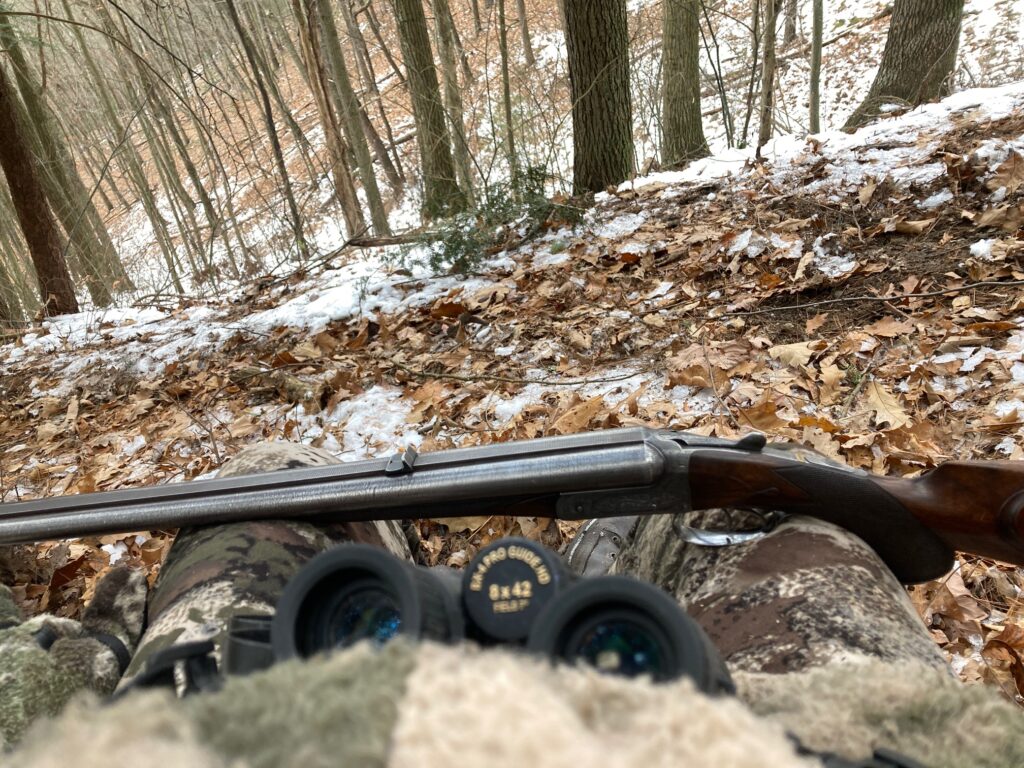
An 1884 double rifle made for tigers in India would be great bear medicine. If only a bear would appear.
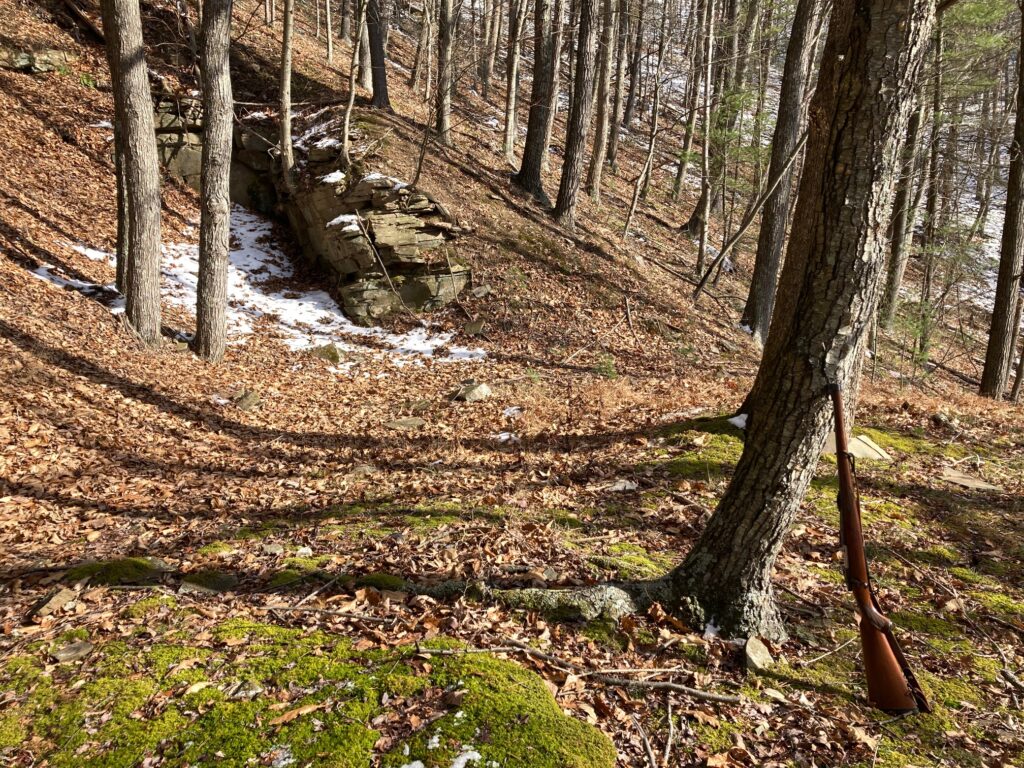
This remote old mine is one of dozens that dot our mountains. It is a fine place to hunt, take a nap, or write in a notebook. A couple times I have done all three in one visit.
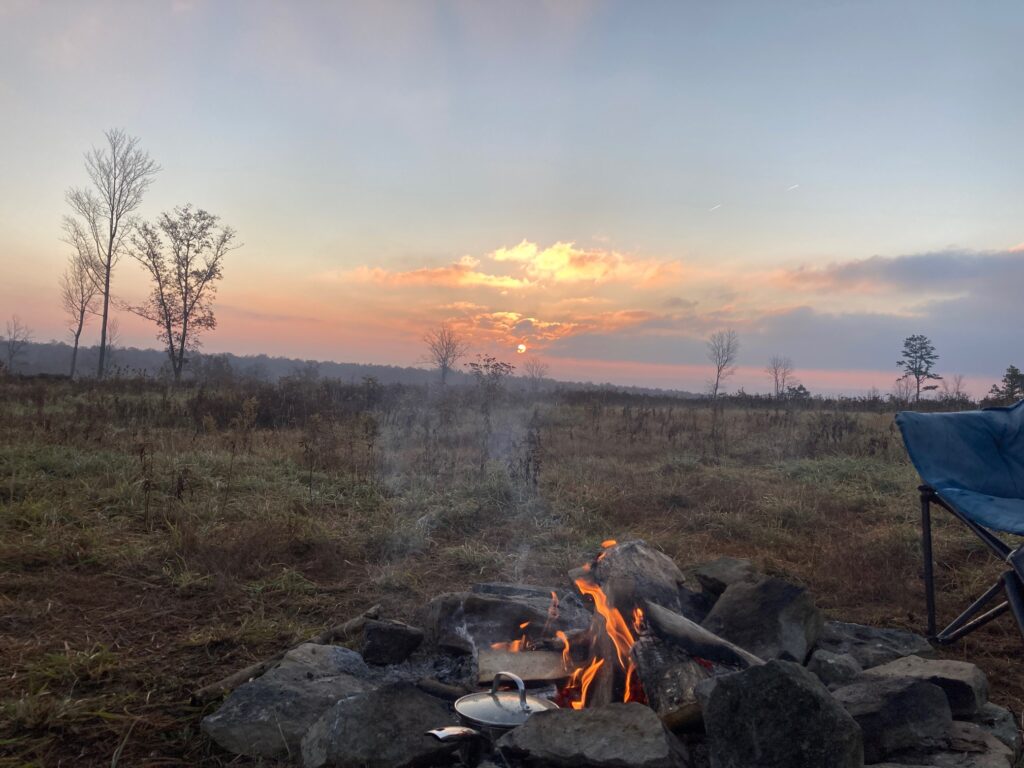
Camped with friends on an old log landing in the Sproul State Forest is a wonderful way to spend life’s limited time, elk or no elk in the bag.
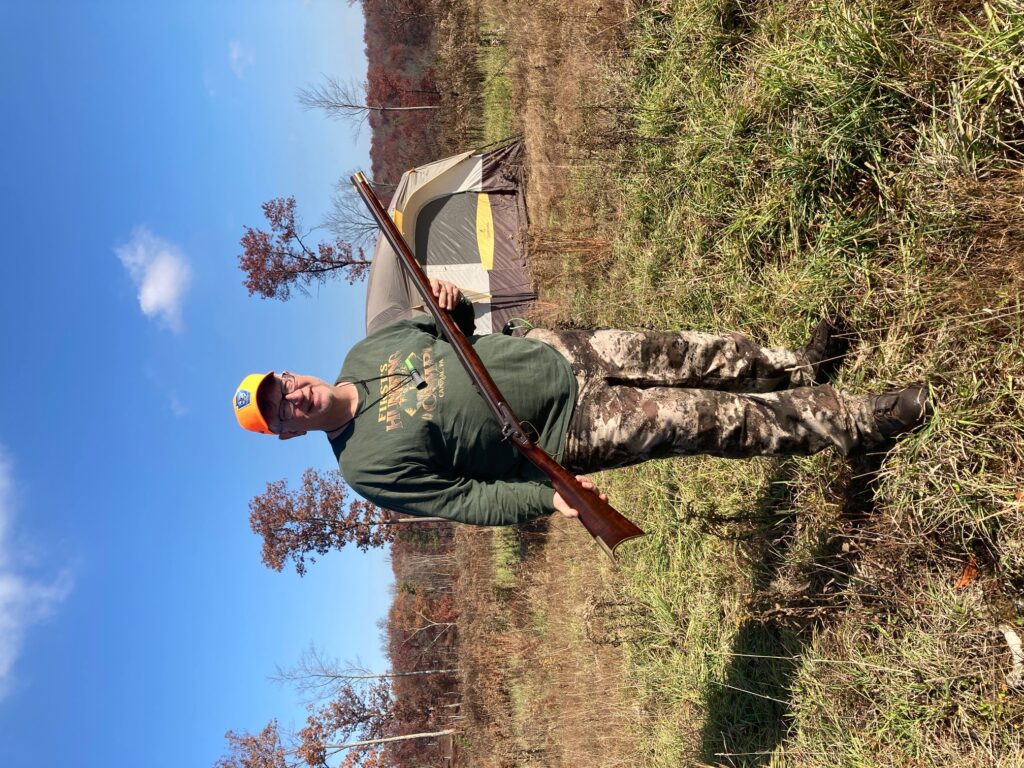
A great way to spend a day hunting elk, with a beautiful .62 caliber rifle (not a smoothbore) made by Mark Wheland here in PA. With its 335-grain round ball, it is easily capable of cleanly taking a hearty elk.
Anatomy of a deer season
It doesn’t matter if you archery hunt for deer religiously, from October 1 to mid-November; the archery season is always over way too fast.
It doesn’t matter if you archery hunt a bit for bear and deer, hunt the week of early muzzleloader for bear and doe, do some small game hunting, have the men up to camp for bear season for four days, and then hunt every day of deer rifle season. The ending is always the same: It ended way too fast. We wait all year for this time, and before you can blink an eye, it is over.
For many hunters, this time is about being afield, hunting. The occasional actual killing part is a welcome indication that the hunting part was done well. Proof that the time spent outside was not wasted.
Oh, we still have some late deer season remaining, which is the late archery and flintlock hunt. But by now, deer everywhere in Pennsylvania are on high alert. A twig falling out of a tree and rustling a leaf on the ground will send a nearby deer herd into panicked stampede into the next county. So getting deeply enough into the sensory zone of these intelligent animals to take one with a bow or a flintlock at this stage takes real skill, not just the usual luck.
Although I will hunt the flintlock deer season, because I have some DMAP tags left, looking back even now with a sense of longing has me thinking about the anatomy of a good deer season. Some take-aways:
- Eat good food. Whether it is home-made jerky and dried fruit we make ourselves for our own time afield, or it is the extra thick gourmet steaks we bring to hunting camp, eat the best quality food you can afford. Hunting alone or with friends and family is a celebration, so eat like you are celebrating. And because Man does not live on bread alone, make sure your drinks are of a commensurate high quality.
- Practice, practice, practice with your gun. Archery hunters practice non-stop, but for some reasons many gun hunters leave it to one box of ammo and the days right before the season to “practice” shooting. Well do I recall sharing a range with a guy from Lancaster County at the bench next to me. Friendly enough, he enthusiastically, if spastically, launched his one box of “extra” shells down range as rapid fire as a bolt action can fire. I had offered him the use of my spotting scope and Caldwell shooting sled, and he declined. He did end up relying on my spotting and calling his hurried shots, however, because he didn’t quite have his scope figured out. The old random “spray n’ pray” is the approach he packed up and drove off to hunting camp with. Do any of us think he hit what he shot at?
- Bring your best jokes, naughty or practical. Hunting camp is fun, and each of us must contribute to that festive atmosphere. Many years ago, I bent down to inspect a strange looking object hiding under the cabin’s kitchen counter. And just as quickly I jumped back and screamed like a little girl when the damned thing took off running. That it was merely a muskrat pelt attached to a fishing line being pulled by Bob and followed by uproarious laughter at my expense just made my revenge all the sweeter. As for naughty jokes and rhymes, the list is endless. Look them up and bring half a dozen. Maybe I am lowbrow, or maybe I have low expectations, but it sure seems that everyone present laughs at these men-only jokes.
- Get out into position early, like at least an hour before first light, and when you move play the wind (nose into the wind), go quietly and slowly, and carry your gun port-arms and not across your back. If you can get out into position at 4:30am, even better. Just bring a blanket and some Zippo hand warmers.
- Food sources matter for deer and bear, too. We humans are not the only ones who both enjoy and need food. In a year of abundant acorns, a stand of sweet tasting white oaks will draw more deer and bear, and you can sit down wind of that stand of trees. In a year of scarce acorns, like this year, any tree that had a decent crop will still draw animals pawing in the leaves for whatever may be left in early December. By this mid-November, almost all of the already scarce acorns were eaten up, and both bear and deer seemed to be moving widely across the landscape in search of any food. It makes for tough hunting, and so we have to team up with buddies and other camps to work together to scoop up what animals are out there. Be flexible and think outside the box of a permanent stand.
- Speak animal language. Last year I grunted in an Adirondacks wilderness buck after busting him out of his bed. He was a territorial and aggressive SOB. But the conditions were all wrong for playing around, and although his body was visible, I could not shoot through the beech brush to get him. This year I returned for Round Two with the same animal, which had probably never seen a human being, and after two days of tentative efforts, Day Three resulted in the furious huge buck storming right in to my position with leaves, twigs, snot and mouth foam flying. I shot him in the neck at five yards, five miles from my truck. Lot of work, totally worth it for that DIY hunt of a lifetime. My position was carefully chosen for what he could see or smell under a certain wind direction. I waited until it was all just right, and let fly. His response was immediate.
- Take pictures, send them in emails. While journaling is not dead, most people today do not write in a personal or camp journal. Instead, we take photos and email them around. The recipients always appreciate them. Especially when ten or twenty years has suddenly passed, our knees don’t seem capable of all those steep climbs and hard sidehilling drives any longer, and a lot of our best times at hunting camp are sitting around with dear friends and reminiscing together. So don’t forget to take pictures and share them.
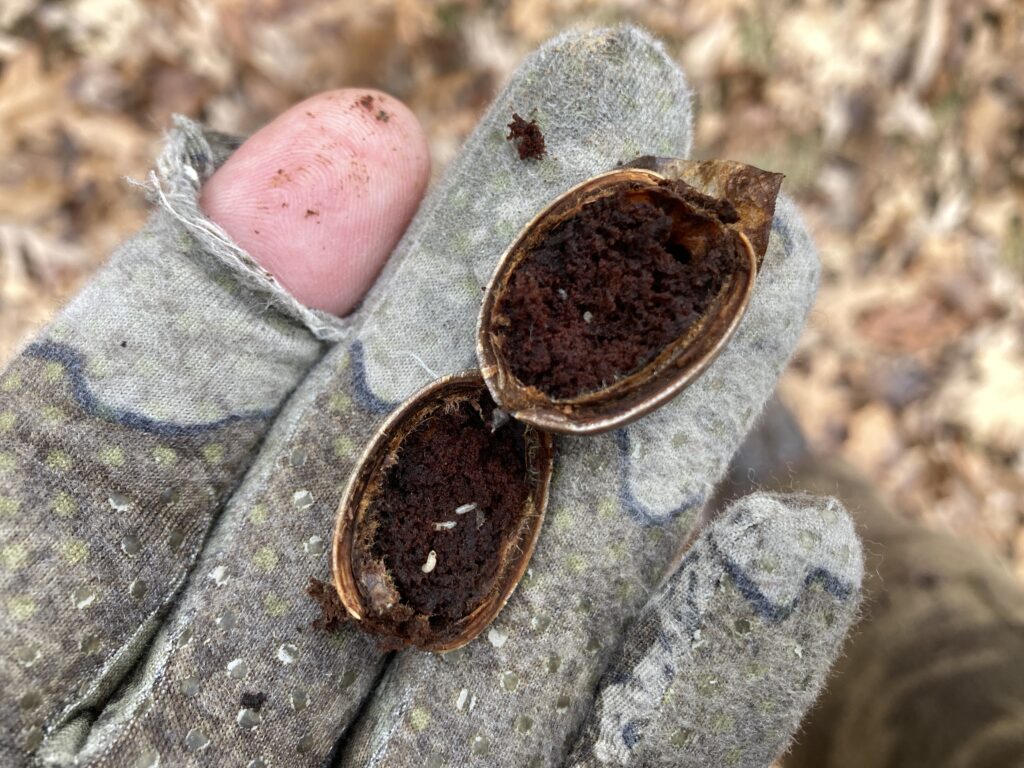
Northern PA’s acorn crop largely failed in 2021, possibly due to a late frost that killed the acorn flowers. Acorns remaining on the ground looked OK from the outside, but were all rotten like this on the inside. Wildlife is hungry and moving widely to locate food.
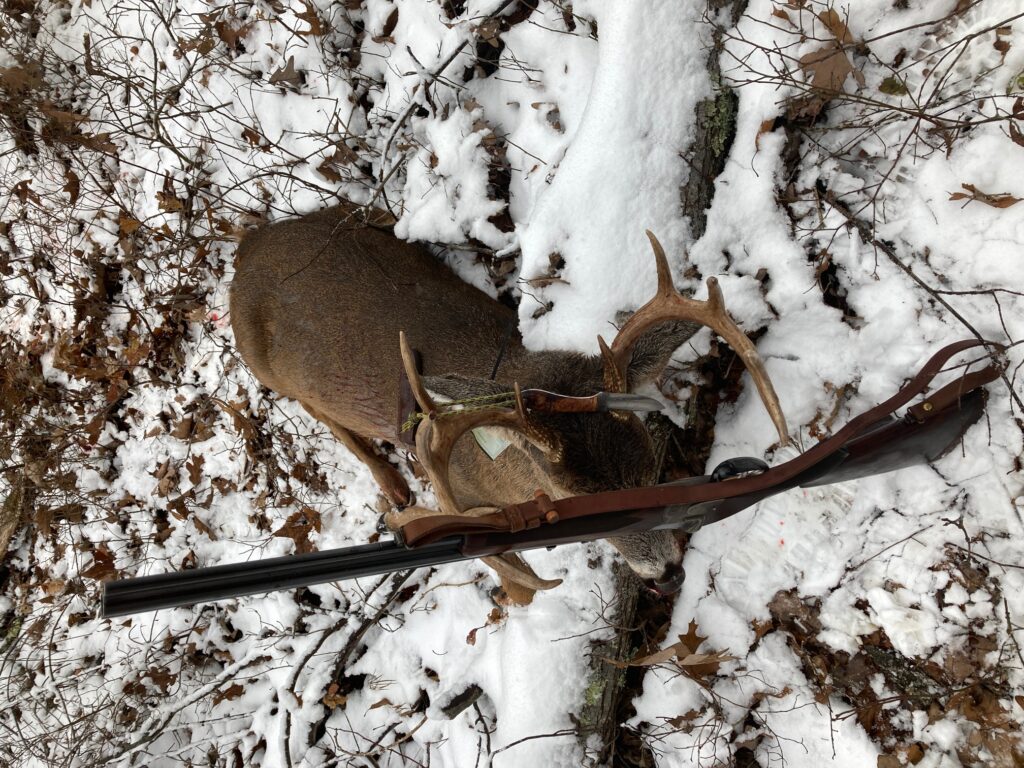
My “Freedom Buck,” killed on Sunday November 28th at 7:45am, on private property in PA. The ban on Sunday hunting is an attack on freedom, and so I named this Sunday morning buck after my declaration of freedom.
Reflections on 2020 bear season
As if by magic or just the batting of an eyelid, the much anticipated 2020 bear season is now behind us, having concluded at dark yesterday. Sad to see our friends go; we had such a fun time! The last of our bear hunting guests have left, cleanup has commenced, preparations are under way for Thanksgiving, and there are some reflections to be had on bear season.
First, where the hell were the bears? Serious question here. We hunt in a mountainous Northcentral area that is Pennsylvania’s “Bear Central.” And despite us daily scouring a lot of remote, very rugged territory that is usually home to lots of bears, we saw neither bears nor bear poop. None. It could be the warm weather has bears hunkered down under cool overhangs in even more remote places. It could be the low acorn crop has bears going in to hibernation early, because there is no more food for them to eat to put on the extra fat they need to hibernate successfully. The truth is, no bear tracks or poops have been seen around here for months, which is remarkable. I cannot think of any year prior like this.
Second, where were all the hunters? We heard only a few shots between Saturday and Sunday, and either none or one on Monday, and for sure none on Tuesday; and very few hunting parties were on the radio on any day. This means that few large scale hunting drives were going on. Without hunters moving across the landscape, the bears don’t have to move out of their way. They can just sit still and not run the risk of exposing their rib cage to a hunter’s bullet. That means that the bears can loaf about in some remote corner, escaping the unseasonable warmth or just waiting for the wafting human scent to drift away before making their usual rounds again. Which means the few hunters who are out don’t see much action.
Third, where were all the other critters, like turkeys and deer? Like with bears, we saw very little deer or turkey poop in the woods. And although I myself saw two whopper bucks and a five-point up close, no one else saw any deer. Nor did any of us see any turkeys. Once again, the absence of these otherwise ubiquitous animals could be due to the relative absence of acorns. Which would push the wildlife far afield to find food sources.
Fourth, despite all of our hunting setbacks, did any of us care a bit? No! We missed all of our friends who could not be with us for various reasons, like fear of the CCP virus, or family emergencies requiring them to stay at home. But those of us who gathered had a lot of fun nonetheless. And with or without a bear on the game pole, we would not have missed this time together for any reason at all. We caught up on our families, our work, our homes, cars, friendships, wives, and politics (yeah, there was a lot of pro-Trump politics). Some people drank way too much alcohol, and we got some great pictures of it all, like the one guy asleep on the cold ground outside. No, we don’t post those here. We ate like kings, that is for sure, and no one lacked for food or drink.
Finally, it is possible that the new early bears seasons (archery, muzzleloader, and special junior+ senior rifle) are removing so many bears from the woods that come rifle season, very few huntable bears remain to be had. According to real-time hunting harvest data posted at the PA Game Commission website, more bears were killed in the early seasons than in the official rifle season this year. This means there are fewer bears available for the rifle hunters. It is possible that many hunters expected this, based on last year’s harvest patterns, and they stayed home or hunted alone, instead of joining the big crew at camp, like usual. As of late today, just 3,138 bears had been killed total this year. That is about a thousand fewer than expected.
Based on this raw data alone, the early bear seasons are actually backfiring. They are not removing the high surplus number of bears that are beyond Pennsylvania’s social carrying capacity. Rather, the early bear seasons are removing the easiest bears and leaving few to be hunted in the later rifle season.
And this new dynamic could be the real story in PA’s bear season: There are so many early season bear hunting opportunities for individuals that they collectively take the wind out of the sails for the regular season hunters, thereby having a boomerang effect on the entire thing and limiting it.
We won’t know what all this data really means for another few years, and by then either great or even fatal damage will have been done to Pennsylvania’s traditional bear camp culture, with its big gatherings and big drives and big camp camaraderie dying out, or we will simply all have to learn to adapt to new ways of hunting. I have to say, there is no substitute for men gathering at a camp to hunt together. The gathered hunting party is the most human of experiences; it is an institution as old as our species. Its purpose was not just making meat, but also social and sociological.
I sure hope these myriad new early bear seasons are not self-defeating, in that they do not kill that traditional bear camp culture by removing its whole purpose ahead of the game. Question for the PGC: What incentive is there to push your body hard through rugged and remote landscapes, destroying your boots, tearing your clothing, and often losing or breaking some of your gear, including damaging your gun, when the animal you are seeking has already been removed?
Below are some photos from one of our trail cameras two years ago. Just days after bear season ended, a bear was caught gloriously and most joyously rubbing its back against a young white pine tree. Almost like a pole dancer. Pretty hot hip shakes there. We haven’t seen a bear anywhere around here since May this year.
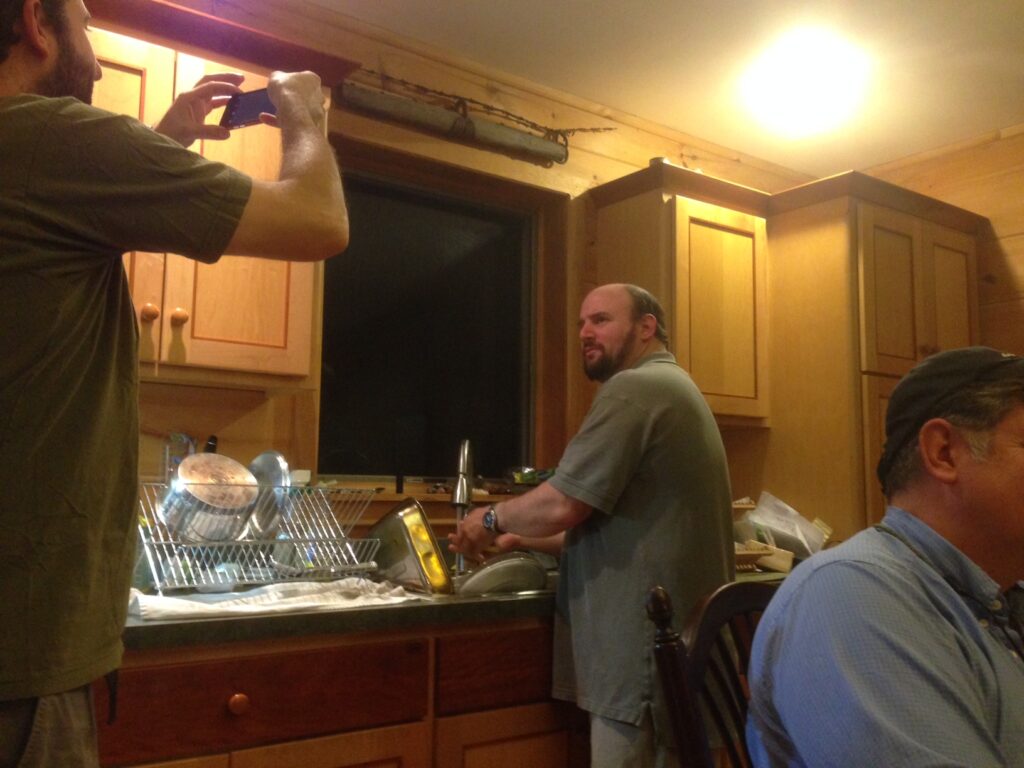
When one of our guys is finally browbeaten into washing dishes after years, it is cause for “Notify the media” acts like taking his unhappy picture. This is back in 2015. He still has to be browbeaten into washing the damned dishes

Lycoming County is the boot-looking shape in the northcentral area. Its northwestern corner is where we hunt. The darkest township there demonstrates the importance of organized hunting drives. A bunch of large hunting clubs are located in this area, and their members put on highly coordinated, obviously successful drives.
Bear and Deer Seasons in the Rearview Mirror
The old joke about Pennsylvania having just two seasons rings as true today as it did fifty years ago: Road construction season in the Keystone State seems to be a nine-month-long affair everywhere we go, a testament to how not to overbuild public infrastructure, if you cannot maintain it right.
And the two-week rifle deer season brings out the passion among nearly one million hunters like an early Christmas morning for little kids (I doubt the Hanukkah bush thing ever took off). All year long people plan their hunts with friends and relatives, take off from work, spend lots of money on gear, equipment, ammunition, food, and gas, and then go off to some place so they can report back their tales of cold and wet and woe to their warmer family members at home. These deer hunts are exciting adventures on the cheap. No bungee jumping, mountain cliff climbing, jumping through flaming hoops or parachuting out of airplanes are needed to generate the thrill of a lifetime as a deer or bear in range gives you a chance to be the best human you can be.
Both bear and deer seasons flew by too fast, and I wish I could do them over, not because I have regrets, but because these moments are so rare, and so meaningful. I love being in the wild, and the cold temperatures give me impetus to keep moving.
One reflection on these seasons is how the incredible acorn crop state-wide kept bear and deer from having to leave their mountain fortresses to find food. Normally animals must move quite a bit to find the browse and nuts they need to nourish their bodies. Well, not this year. Even yesterday I was tripping over super abundant acorns lying on every trail, human or animal made.
When acorns are still lying in the middle of a trail in December, where animals walk, then you know there are a lot of nuts, because normally those low-hanging fruits would be gobbled right up weeks ago.
After still hunting and driving off the mountain I hunt on most up north, it became clear the bear and deer were holed up in two very rugged, remote, laurel-choked difficult places to hunt. Any human approach is quickly heard, seen, or smelled, giving the critters their chance to simply walk away before the clumsy human arrives. All these animals had to do was get up a couple times a day, stretch, walk three feet and eat as many acorns as they want, and then return to their hidden beds.
This made killing them very difficult, and the lower bear and deer harvests show that. God help us if Sudden Oak Death blight hits Pennsylvania, because that will spell the end of the abundant game animals we enjoy, as well as the dominant oak forests they live in.
The second reflection is how we had no snow until Friday afternoon, two days ago, and by then we had already sidehilled on goat paths, and climbed steep mountains, as much as we were going to at that late point in the season. With snow, hunting is a totally different experience: The quarry stands out against the white back ground, making them easier to spot and kill, and snow tracking shows you where they were, where they were going, and when. These are big advantages to the hunter. Only on Friday afternoon did we see all the snowy tracks up top, leading over the steep edge into Truman Run. With another two hours, we could have done a small push and killed a couple deer. But not this year. Maybe in flintlock season!
And finally, I reflect on the people and the beautiful wild places we visited.
I already miss the time I spent with my son on stand the first week. He was with me when I took a small doe with a historic rifle that had not killed since October 1902, the last time its first owner hunted and a month before the gun was essentially put into storage until now.
And then my son had a terrible case of buck fever when a huge buck walked past him well within range of his Ruger .357 Magnum rifle, and he missed, fell down, and managed to somehow eject the clip and throw the second live round into the leaves while the deer kept moseying on by. When I found my son minutes later, he was sitting in a pile of leaves where the deer had stood, throwing the leaves around and crying in a rage that we needed to get right after the deer and hunt them down. The boy was a mess. It was delightful to watch.
I miss the wonderful men I hunted with, and I miss watching other parents take their own kids out, to pass on the ancient skill set as old as humankind.
It is an unfortunate necessity to point out that powerline contractor Haverfield ruined the Opening Day of deer season for about three dozen hunters by arriving unannounced and trespassing in force to access a powerline for annual maintenance in Dauphin County. We witnessed an unparalleled arrogance, dismissiveness, and incompetence by Haverfield staff and ownership that boggles the mind. I am a small business owner, and I’d be bankrupt in three days if I behaved like that. Only the intervention of a Pennsylvania Game Commission Wildlife Conservation Officer saved the day, and that was because the Haverfield fools were going onto adjoining State Game Lands, where they also had no business being during deer season.
Kudos to PPL staff for helping us resolve this so it never happens again.
Folks, we will see you in flintlock season, just around the corner. Now it is time to trap for the little ground predators that raid the nests of ducks, geese, grouse, turkey, woodcock, and migratory songbirds. If you hate trapping, then you hate cute little ducklings, because the super overabundant raccoons, possums, skunks, fox, and coyotes I pursue eat their eggs in the nests, and they eat the baby birds when they are most vulnerable.
Hunting licenses, 1976 and 2015
Since my first hunting license adorned my back way back in 1976-1977, a lot has changed in the Pennsylvania landscape.
For example, wild game then so abundant that you could go out and shoot a couple for dinner is now practically extirpated.
Why pheasants and quail disappeared from Pennsylvania is a big debate with no clear answers. Loss of farmland to sprawl, low density development is one. Changes in farming practices is another; fallow fields had the best habitat. A plethora of winged and four legged predators cannot be discounted. Successfully rebounding populations of raptors like hawks and owls for sure ate a lot of plump pheasants. But why a sudden and dramatic crash?
Conservation successes since 1976 are plentiful and say a lot about wildlife biology. Wild turkey populations, fishers, bobcats and other animals once thought completely gone are now firmly in our lives, whether we see them, or not.
An interesting dynamic is playing out at our hunting camp. This year we have a virtual carpet of oak and hickory seedlings unlike anything we saw over the past 15 years we’ve owned it. Why?
Conventional wisdom is the deer population is low, and it’s true that it’s lower than it has been in 15 years. That is, deer are known eaters of acorns and tree seedlings. Fewer deer means more of both.
However, another factor seems to be playing out with these newly abundant tree seedlings. Where we once had an incredible overload of tree rats, aka squirrels, the new fishers have eaten them all. Like all of them. Not one tree rat remains in our carefully cultivated forest of white oaks. We see fisher tracks. We neither see nor hear squirrels.
As squirrels are known eaters of acorns and hickories, it stands to reason that their absence means more acorns and hickories hatching into baby trees.
Add a long icy winter that appears to have crushed our local wild turkey populations, also known for eating nuts, and the right conditions emerge to help a forest rebound and grow some new stock, a huge challenge we aggressively tackle every year.
So, my son getting his first hunting license yesterday is now entering a landscape that in some ways is just as dynamic as the one I began hunting so long ago. What a difference these landscapes were and are, and who would’ve guessed the fishers would be responsible for oak and hickory forests regenerating?
A lot has changed in our wildlife landscapes, and yet not much has changed in my lifetime. Different animals, same kind of population changes, variations, pressures. One thing I keep reminding myself: It’s all natural, these changes. And while some are painful to see, like the loss of pheasants, other opportunities open up. Never would I have imagined in 1976, nor would any PA Game Commission staff, that in 2015 my son would get a bobcat tag and a fisher tag with his license.
Totally different opportunity than chasing pheasants in corn fields, but still good.
